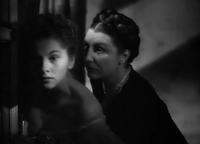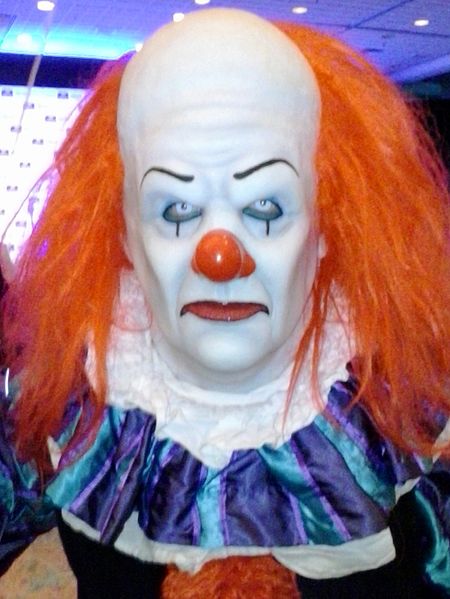 creepiness,
creepiness,  creepy,
creepy,  psychology,
psychology,  science
science  Wednesday, October 12, 2016 at 02:17AM
Wednesday, October 12, 2016 at 02:17AM  Up much too close and personal with Mrs Danvers (Judith Anderson) in Alfred Hitchcock's 'Rebecca'Long before the creepy clown epidemic, we have all experienced the feeling of “creepiness”, sometimes triggered by a building or a location, often by a person. It might be a neighbour, a TV character or a stranger. Creepiness is quite distinct from fear. The uncomfortable sense that there might be something dangerous or unpleasant in the bushes inspires a completely different felling than that which you experience when you actually see the bear, or the guy holding the knife (or binoculars).
Up much too close and personal with Mrs Danvers (Judith Anderson) in Alfred Hitchcock's 'Rebecca'Long before the creepy clown epidemic, we have all experienced the feeling of “creepiness”, sometimes triggered by a building or a location, often by a person. It might be a neighbour, a TV character or a stranger. Creepiness is quite distinct from fear. The uncomfortable sense that there might be something dangerous or unpleasant in the bushes inspires a completely different felling than that which you experience when you actually see the bear, or the guy holding the knife (or binoculars).
According to the authors of a new study, 'On the nature of creepiness', the uncertainty about whether a theat is real or not (or the ambiguity about what the thtreat might actually be), is central to the sense of creepiness.
Francis McAndrew and Sara Koehnke (Knox College, Illinois) were surprised that, despite the widely accepted experience of creepiness, there were no previous scientific studies exploring the condition. They collated more than 1,300 responses to an online survey about perceptions of creepiness. They found that males are much more likely to be creepy than females and that females often perceive a sexual threat from a creepy person. They also noted that some professions predispose their practitioners to perceptions of creepiness, notably clowns, taxidermists, sex shop owners and funeral directors.
Funeral directors are almost certainly an integral part of a modern economy. Arguably sex shops are too and most people would recognise the scientific benefits of taxidermy. I suspect, however, that most people are uncomfortable with excessive exposure to sex and death (especially with strangers) so people who choose these professions might appear to have slightly different norms to most people, hence a degree of discomfort.
 Creepy clown, image by GabboTThen there’s clowns. They look similar to the rest of us, but their emotional expression is disarmingly simplified and usually more extreme, and their behaviour clashes with many social rules. This is the very reason clowns can be entertaining – they are recognisably human, but their behaviour moves beyond socially acceptable boundaries, making them a target for ridicule. They can help us embrace silliness and perhaps make us feel comparatively clever and erudite. Their tomfoolery reinforces the strength of our social rules. The other thing about clowns that might make them especially creepy is that there is clearly someone under the makeup or mask. There is something unseen or unclear, tapping into the concept I described earlier of ambiguity or uncertainty of danger. There’s an interesting article on the history and psychology of clowning in the Smithsonian magazine.
Creepy clown, image by GabboTThen there’s clowns. They look similar to the rest of us, but their emotional expression is disarmingly simplified and usually more extreme, and their behaviour clashes with many social rules. This is the very reason clowns can be entertaining – they are recognisably human, but their behaviour moves beyond socially acceptable boundaries, making them a target for ridicule. They can help us embrace silliness and perhaps make us feel comparatively clever and erudite. Their tomfoolery reinforces the strength of our social rules. The other thing about clowns that might make them especially creepy is that there is clearly someone under the makeup or mask. There is something unseen or unclear, tapping into the concept I described earlier of ambiguity or uncertainty of danger. There’s an interesting article on the history and psychology of clowning in the Smithsonian magazine.
McAndrew and Koehnke identified several characteristics of creepiness, including having unkempt or greasy hair (‘The Ring’, anyone?); having a peculiar smile (e.g. the Joker); very pale skin (like most clowns, Voldemort and Edward Scissorhands); licking ones lips frequently; standing too close to people; and laughing at unpredictable times (e.g. Max Cady).
 The Child CatcherI remember being completely freaked out by Robert Helpman’s Child Catcher in ‘Chitty Chitty Bang Bang’, who employed several of these features.
The Child CatcherI remember being completely freaked out by Robert Helpman’s Child Catcher in ‘Chitty Chitty Bang Bang’, who employed several of these features.
The study found that hobbies that are seen as a bit creepy include collecting dolls or body parts such as teeth, bones, or fingernails, as well as anything that involved some variation of watching, following, or taking pictures of people. Agreed.
Most respondents (nearly 60%) to McAndrew and Koehnkes’ survey said that they thought creepy people did not know they were creepy. A further 32% were “unsure”. So, perhaps we should cut creepy people just a little bit of slack. Perhaps not.
The study appears in the journal New Ideas in Psychology.
 creepiness,
creepiness,  creepy,
creepy,  psychology,
psychology,  science
science